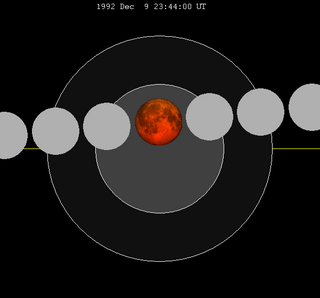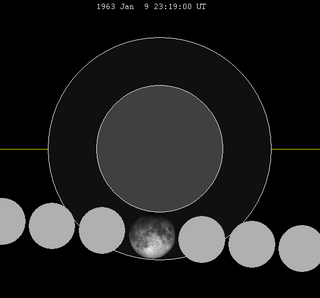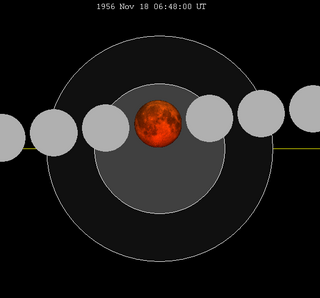
A total lunar eclipse took place on Sunday, November 9, 2003, the second of two total lunar eclipses in 2003, the first being on May 16, 2003. It is the first total lunar eclipse of 21st century which happened on a micromoon day. The Moon barely edged into total eclipse for 21 minutes and 58 seconds. With the Moon just 1.78% of its diameter into the Earth's umbral shadow, the Moon may have been quite bright, but even so, this should have been worth seeing. The partial eclipse lasted for 3 hours, 31 minutes and 25 seconds. Occurring only 1.4 days before apogee, the Moon's apparent diameter was 6.4% smaller than average.

A total lunar eclipse took place on Wednesday, December 9, 1992, the second of two lunar eclipses in 1992, the first was a partial lunar eclipse on Monday, June 15.

A penumbral lunar eclipse took place on Sunday, January 31, 1999, the first of two lunar eclipses in 1999.

A penumbral lunar eclipse took place on Friday, March 13, 1998, the first of three lunar eclipses in 1998.
A total lunar eclipse took place on Monday, October 28, 1985, the second of two total lunar eclipses in 1985, the first being on May 4, 1985.
A penumbral lunar eclipse took place on Wednesday, June 13, 1984, the second of three lunar eclipses in 1984. This minor penumbral eclipse was visually imperceptible, but marks the first lunar eclipse in Saros series 149.

A partial lunar eclipse occurred on 19 November 2021. The eclipse occurred towards a micromoon. This was the longest partial lunar eclipse since 18 February 1440, and the longest until 8 February, 2669; however, many eclipses, including the November 2022 lunar eclipse, have a longer period of umbral contact at next to 3 hours 40 minutes. It was often referred to as a "Beaver Blood Moon" although not technically fulfilling the criteria for a true blood moon (totality).
A partial lunar eclipse took place on Tuesday, March 13, 1979, the first of two lunar eclipses in 1979. The Moon was strikingly shadowed in this deep partial eclipse which lasted 3 hours, 17 minutes and 40.6 seconds, with 85.377% of the Moon in darkness at maximum.

A partial lunar eclipse will take place on November 30, 2039. At 3 hours 26 minutes, it is the longest partial lunar eclipse since November 19, 2021, which is the previous member of Lunar Saros 126.
A partial lunar eclipse took place on Thursday, May 13, 1976, the first of two lunar eclipses in 1976, the second being a penumbral lunar eclipse on November 6, 1976. At maximum eclipse, a small bite out of the Moon should have been visible. The eclipse lasted for 1 hour, 15 minutes and 23.8 seconds, with just 12.17% of the Moon in shadow at maximum. Occurring only 1.1 days after perigee, the Moon's apparent diameter 5.4% larger than average.

A total lunar eclipse took place on Wednesday, October 18, 1967, the second of two total lunar eclipses in 1967, the first being on April 24, 1967.

A penumbral lunar eclipse took place on Wednesday, January 9, 1963, the first of three lunar eclipses in 1963.

A total lunar eclipse took place on Sunday, March 13, 1960. The moon passed through the center of the Earth's shadow.

A total lunar eclipse took place on Monday, September 5, 1960. The moon passed through the center of the Earth's shadow.

A total lunar eclipse took place on Sunday, November 18, 1956.

A partial lunar eclipse took place on Thursday, May 24, 1956. It was the first eclipse of the last partial set in Saros series 120.
A total lunar eclipse took place on Monday, September 15, 1913. The moon passed through the center of the Earth's shadow.

Saros cycle series 114 for lunar eclipses occurs at the moon's ascending node, 18 years 11 and 1/3 days. It contains 71 member events, with 13 total eclipses, starting in 1458 and ending in 1674. Solar saros 121 interleaves with this lunar saros with an event occurring every 9 years 5 days alternating between each saros series.

A total lunar eclipse took place on Friday, October 7, 1949, the second of two lunar eclipses in 1949.


































